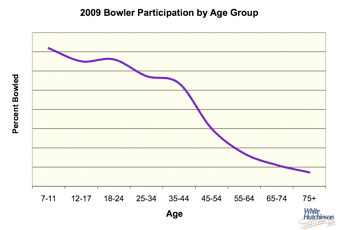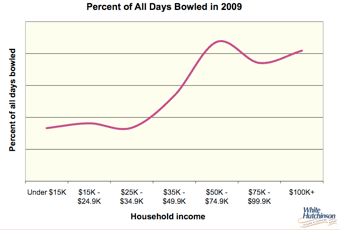
Vol. X, No. 6, October 2010
- The foundation of location-based entertainment success is a four-legged stool
- Meet us in Orlando at IAAPA
- What's up with bowling?
- New Motion Evolution program for children
- Out-of-home entertainment spending on the increase for families with children
- White Hutchinson joins The Optimus Group
- Follow our tweets
- Top 20 most loved brands
What's up with bowling?
Bowling continues to increase in popularity with the open play bowler (non-league bowler). One of the primary reasons for this growth trend are the new models of more upscale and attractive bowling centers that are 100% open play and the hybridization of bowling centers to include other attractions. This applies not only to bowling lounges and boutique bowling that target the young adult market, but also to what are know as hybrid bowling centers that target the family market with additional family entertainment attractions. Many of the hybrid bowling centers could be better described as family entertainment centers (FECs) that include bowling as an anchor attraction. An appealing feature of most of these newer or renovated bowling centers is their more upscale food and beverage offerings in addition to their more attractive interior finish (see previous article The foundation of location-based entertainment success is a four-legged stool).
Bowling has the highest participation rate of any form of indoor recreation other than swimming. It also has intergeneration appeal – any age from 2 to centenarian can bowl – and it is a great social experience when people want to get out of the house and have some fun together.
Our company regularly conducts research on who bowls so we can help our clients find the best locations for centers and fine-tune their centers to their markets for maximum profitability. Although most of our research is proprietary, we can share this with you. The highest bowling participation is among children and younger adults and with those in higher income households. Bowlers in the 7 to 44-age category represent over 81% of all bowlers age 7 and older. These of course are the two largest target markets for bowling – families with children and young adults. Consumers living in households with $75,000 and higher incomes are only 31% of all consumers, yet they account for over 45% of all days bowled. Consumers with household incomes of $50,000 and greater account for over two-thirds of all days bowled.


We just completed some primary research on bowling for one of our clients and found that the popularity of bowling for moms with younger children is even higher than what much of the other research shows. This corresponds to an earlier analysis we did based upon households’ lifestyle-socioeconomics that found the highest bowling participation rate was with families with children. Of course, to get moms to show up with their families, you have to offer clean, attractive and quality facilities with great food and beverage service (this doesn’t mean a snack bar). Moms are far more sensitive to a center’s atmosphere, cleanliness and food than men.
Our company is currently working on six different projects that include bowling, four are new centers and two are renovations. All are new models that target the upscale market, some a primary market of families and some young adults.
Our first location-based entertainment project was the design and production of a new bowling center back in 1989 when Olathe Lanes East, then an old-style bowling alley in a suburban area of Kansas City, burned to the ground and we were hired to handle its redevelopment. Our research found the majority of its customers were white-collar, and 51% were women - even though the owner told us his average customers were "beer guzzling blue-collar men." So we matched the new bowling center to its market with upscale art deco décor, cocktail seating on the concourse (the old-style settee seating was designed for leagues, not open-play bowlers), a one level floor and approaches (an industry first), windows and skylights, no settee seating but rather cocktail seating (an industry first) hand-made hamburgers and great restrooms. Guess what? After the center reopened, revenue doubled, food and beverage sales quadrupled and the center was able to command a 35% premium price for bowling over other bowling centers in town.
We then remodeled the same owners other bowling facility, Olathe Lanes West, on the other side of the railroad tracks that catered to a more blue-collar market. We pushed everything out the door with a Bobcat t for the lanes and then remodeled using a Southwestern décor that matched that market’s socio-economic with cocktail seating and upgraded food. Its business increased 35% after reopening.
Both centers were a great first lesson for us. Match the product to the target market and the business and profits will grow with nothing else in the market being different. This is basic marketing and what’s known as the elasticity of consumer demand – consumer spending will increase when you give them a previously unavailable product, service or experience that matches their needs, wants and values. We've been helping clients be successful ever since by never forgetting that basic marketing principle.
Vol. X, No. 6, October 2010
- The foundation of location-based entertainment success is a four-legged stool
- Meet us in Orlando at IAAPA
- What's up with bowling?
- New Motion Evolution program for children
- Out-of-home entertainment spending on the increase for families with children
- White Hutchinson joins The Optimus Group
- Follow our tweets
- Top 20 most loved brands


